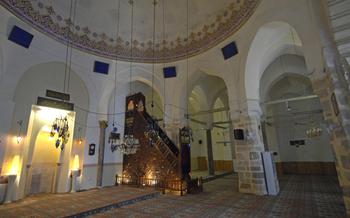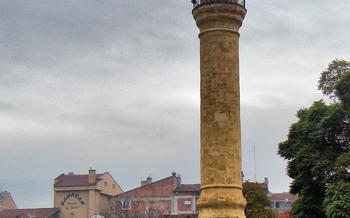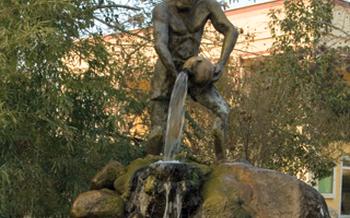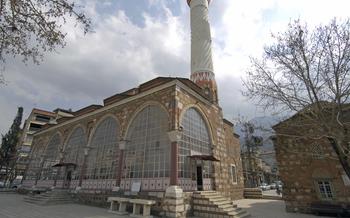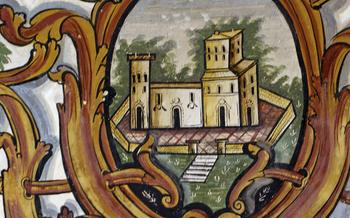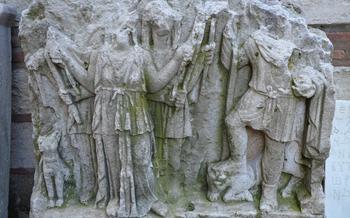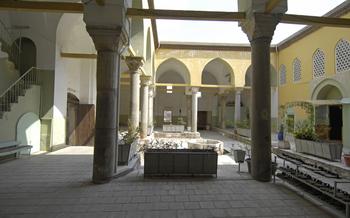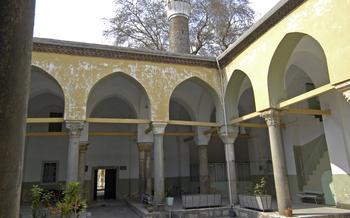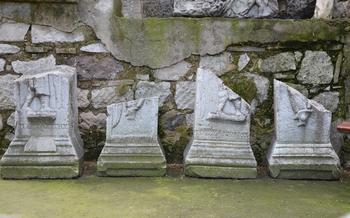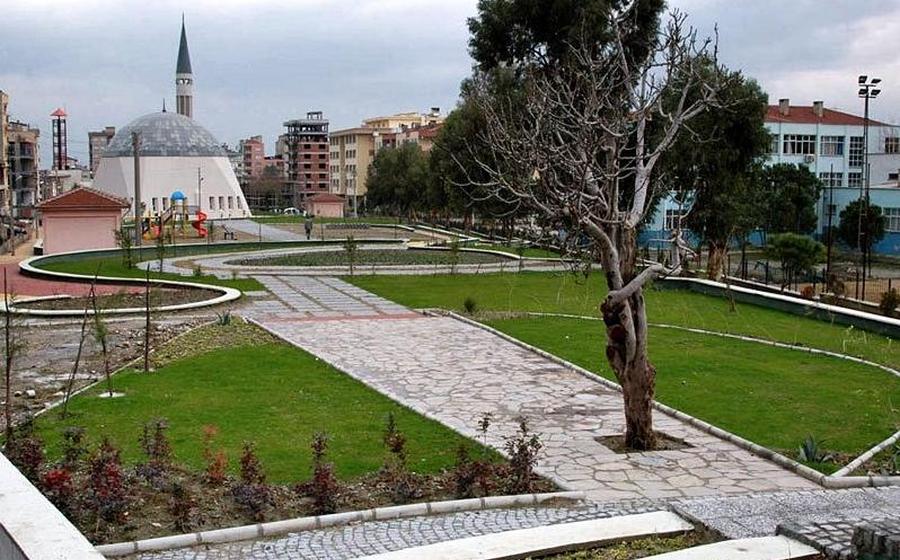
Manisa Great Mosque Madrasah
- The Manisa Great Mosque and Madrasah: A Legacy of Architectural Grandeur
- Stepping into the Past: Exploring the Mosque's Interior
- Unveiling the Madrasah: A Center of Learning and Knowledge
- The Courtyard: A Place of Tranquility and Reflection
- The Minaret: A Beacon of Faith and Symbol of Divine Presence
- The Museum: A Treasure Trove of Islamic Art and History
- Local Customs and Traditions: Embracing Turkish Culture
- The City of Manisa: A Tapestry of History and Nature
- Accommodation Options: Finding Your Home Away from Home
- Transportation Tips: Navigating Manisa with Ease
- Planning Your Visit: Making the Most of Your Time
- Photography and Videography: Capturing the Beauty
- Solo Travel: Embracing the Journey Alone
- Family-Friendly Activities: Engaging Kids and Adults Alike
- Insider Tip: Discovering Hidden Gems
The Manisa Great Mosque and Madrasah: A Legacy of Architectural Grandeur
The Manisa Great Mosque and Madrasah, standing tall in the heart of Manisa, Turkey, is a testament to the city's rich history and cultural heritage. Built in the 14th century during the reign of the Beylik of Saruhan, the mosque and madrasah complex holds significant religious and architectural importance. Its elegant facade, intricate tilework, and harmonious design reflect the fusion of Seljuk and Ottoman architectural styles, making it a captivating sight for visitors from around the world.
The mosque's spacious prayer hall is adorned with stunning frescoes, intricate carvings, and mesmerizing calligraphy, creating an atmosphere of tranquility and devotion. The mihrab, a sacred niche indicating the direction of Mecca, is adorned with intricate tilework and serves as the focal point of the prayer hall. The towering minaret, a symbol of faith and divine presence, offers panoramic views of the city and the surrounding landscapes, inviting visitors to marvel at the beauty of Manisa and its surroundings.
To reach this architectural masterpiece, visitors can easily access the mosque and madrasah complex, situated in the heart of the city. Whether arriving by foot, public transportation, or private vehicle, the complex is conveniently located and well-connected, making it accessible to all who seek to explore its wonders.
Stepping into the Past: Exploring the Mosque's Interior
As you step through the grand entrance of the Manisa Great Mosque, a sense of reverence and awe washes over you. The vast prayer hall, with its soaring arches and intricate tilework, transports you back in time to an era of architectural splendor. The soft echoes of footsteps on the marble floor add to the ethereal atmosphere, creating a space conducive to contemplation and prayer.
The intricate tilework that adorns the walls and ceiling of the mosque is a testament to the artistry and craftsmanship of the Seljuk artisans. Geometric patterns and vibrant colors intertwine to form mesmerizing designs that captivate the eye. The mihrab, the niche that indicates the qibla (direction of prayer), is a masterpiece of Islamic art, featuring intricate carvings and colorful tiles that draw the gaze towards Mecca.
The minbar, the pulpit from which the imam delivers his sermons, is another focal point of the mosque's interior. Its elegant design, with its intricately carved wooden panels and inlaid mother-of-pearl, reflects the importance of religious teachings in Islamic society.
Unveiling the Madrasah: A Center of Learning and Knowledge
The madrasah attached to the Manisa Great Mosque holds a significant place in the history of Islamic education. Established as an integral part of the mosque complex, it served as a center of learning and knowledge for centuries. The madrasah's architectural design reflects its primary purpose, featuring spacious classrooms, libraries, and study halls arranged around a central courtyard.
One of the most striking features of the madrasah is its intricate tilework and decorative elements, which adorn the walls and ceilings of the classrooms. These intricate designs showcase the skill and artistry of the craftsmen who created them, and contribute to the overall aesthetic appeal of the madrasah.
Beyond its architectural beauty, the madrasah played a crucial role in shaping the intellectual and cultural landscape of Manisa. It was a place where students from all walks of life came to study various Islamic sciences, including theology, law, and philosophy. The madrasah's curriculum also included subjects like mathematics, astronomy, and medicine, reflecting the holistic approach to education that was prevalent in Islamic societies.
The madrasah's contributions extended beyond the walls of the institution. Its graduates went on to become scholars, jurists, and statesmen who played a vital role in the development of Islamic civilization. The madrasah's impact can still be felt today, as it continues to inspire and educate generations of students and visitors alike.
The Courtyard: A Place of Tranquility and Reflection
The central courtyard of the Manisa Great Mosque Madrasah serves as a sanctuary of tranquility and reflection, inviting visitors to pause and soak in the serene atmosphere. Step into this open space, and you'll be greeted by a sense of peace and serenity that washes away the stresses of the outside world.
The courtyard is a testament to Islamic architecture's profound appreciation for natural elements. Its design incorporates lush gardens, adorned with vibrant flowers and aromatic herbs, creating a soothing ambiance that complements the spiritual nature of the site. The rhythmic sound of water trickling from the ablution fountain adds a layer of tranquility, echoing the importance of purification in Islamic rituals.
Surrounding the courtyard are elegant arched walkways, supported by intricately carved columns. These walkways provide shelter from the sun and rain, allowing visitors to leisurely stroll and admire the architectural details that adorn the madrasah's exterior. The interplay of light and shadow, as sunlight filters through the arches, creates a mesmerizing effect, further enhancing the courtyard's serene charm.
Take a moment to sit on one of the benches scattered around the courtyard, allowing your mind to wander and your spirit to find solace. Observe the gentle dance of leaves in the breeze, listen to the melodious chirping of birds, and let the tranquility of this sacred space envelop you, leaving you refreshed and rejuvenated.
The Minaret: A Beacon of Faith and Symbol of Divine Presence
Towering over the Manisa cityscape, the minaret of the Manisa Great Mosque stands as a beacon of faith and a symbol of the divine presence. Constructed in the 14th century, this architectural masterpiece showcases intricate stonework and decorative details that reflect the finest craftsmanship of the era. The minaret's slender cylindrical form tapers gracefully towards the heavens, culminating in a delicate crown that resembles a blooming flower.
As the sun casts its golden rays upon the minaret, its surface shimmers and glows, creating a mesmerizing spectacle. The muezzin, a designated caller to prayer, ascends the minaret's winding staircase five times a day to perform the melodious call to prayer, known as the adhan. His voice reverberates through the airwaves, beckoning the faithful to come together in prayer and worship.
The minaret's strategic placement atop the mosque ensures that the adhan reaches every corner of the city, inviting believers to pause their daily activities and turn their hearts towards Mecca. It serves as a constant reminder of the divine presence and the importance of prayer in the lives of Muslims.
The Museum: A Treasure Trove of Islamic Art and History
The Manisa Great Mosque and Madrasah Museum is a testament to the rich history and cultural heritage of the region. It houses a collection of artifacts and exhibits that provide visitors with a deeper understanding of Islamic art, history, and traditions. The museum's collection includes intricate manuscripts, calligraphy works, ceramic pieces, and textiles that showcase the artistic prowess of the Islamic world.
Visitors can explore galleries dedicated to various periods of Islamic history and admire the exquisite craftsmanship of the artifacts on display. The museum also hosts temporary exhibitions, workshops, and lectures that delve into different aspects of Islamic culture and heritage. Whether you're an art enthusiast, a history buff, or simply curious about the Islamic world, the Manisa Great Mosque and Madrasah Museum is a must-visit destination.
Local Customs and Traditions: Embracing Turkish Culture
When visiting the Manisa Great Mosque and Madrasah, it is important to be respectful of local customs and traditions. Visitors should dress modestly, covering their shoulders and knees. Women may also choose to cover their hair. Upon entering the mosque, visitors should remove their shoes and place them in the designated racks. It is customary to perform ablution before prayer, and ablution fountains are provided in the courtyard.
During prayer times, visitors are welcome to observe from the designated areas without disturbing the worshippers. It is important to maintain silence and avoid talking or making noise. If you wish to interact with locals, a friendly smile and a greeting in Turkish will go a long way. Remember that cultural exchange is a two-way street, and showing respect for local customs will foster understanding and create a welcoming atmosphere for all.
The City of Manisa: A Tapestry of History and Nature
Beyond the Manisa Great Mosque and Madrasah, the city of Manisa itself is a treasure trove of historical and natural wonders. Steeped in a rich past, Manisa served as the capital of the Saruhan Beylik, a beylik of the Beylik period. This legacy is evident in the city's many historical sites, including the Muradiye Mosque, the Hatuniye Mosque, and the Manisa Castle.
Manisa's natural beauty is equally captivating. The city is surrounded by lush green mountains and fertile plains, offering breathtaking views and opportunities for outdoor activities. Take a leisurely hike through the Spil Mountain National Park, marvel at the cascading waters of the Manisa Waterfall, or embark on a scenic bike ride along the banks of the Gediz River.
Indulge in the local cuisine, a harmonious blend of Turkish and Aegean flavors. Savor the delectable Manisa kebab, a tender lamb dish cooked on a skewer, or tantalize your taste buds with the region's famous mesir paste, a sweet treat made from 41 different spices.
Accommodation Options: Finding Your Home Away from Home
When planning your stay in Manisa, you'll find a range of accommodation options to suit different budgets and preferences. For a truly immersive experience, consider staying in a traditional Turkish guesthouse. These cozy establishments offer a warm welcome and provide a glimpse into local life. You'll be able to interact with friendly hosts, savor delicious home-cooked meals, and experience the authentic charm of Turkish hospitality.
For those seeking comfort and convenience, several modern hotels are located near the Manisa Great Mosque and Madrasah. These hotels offer amenities such as comfortable rooms, room service, and concierge services. Whether you prefer a traditional or modern setting, you'll find a welcoming and comfortable place to stay in Manisa.
Here are some tips for finding affordable and comfortable accommodation in Manisa:
-
Book your accommodation in advance, especially if you're traveling during peak season.
-
Consider staying in a guesthouse or hostel for a more budget-friendly option.
-
Look for hotels or guesthouses that offer discounts or special packages.
-
Don't be afraid to negotiate prices, especially if you're staying for a longer period.
-
Take advantage of the Turkish hospitality and ask for recommendations from locals.
Transportation Tips: Navigating Manisa with Ease
Getting around Manisa is a breeze, with various transportation options available to suit every preference and budget. The city's public transportation system is efficient and affordable, with buses and trams connecting the mosque to other parts of the city. For those who prefer a more independent mode of exploration, renting a car or bicycle is an excellent option. Manisa's streets are generally well-maintained and easy to navigate, making it a pleasure to explore on two or four wheels. Whether you choose to navigate the city's streets on foot, by public transport, or by rented vehicle, you'll find that Manisa is a city that's easy to get around and explore.
Planning Your Visit: Making the Most of Your Time
When planning your visit to the Manisa Great Mosque and Madrasah, there are a few things to consider to make the most of your experience. If you are interested in delving deep into the history and significance of the mosque and madrasah, it is advisable to allocate at least two to three hours for your visit. This will provide ample time to explore the prayer hall, the madrasah, the courtyard, and the museum, while also taking in the intricate details and architectural features.
For those with limited time, a one-hour visit can still offer a glimpse into the beauty and grandeur of the mosque. Focus on the main highlights, such as the prayer hall, the courtyard, and the minaret. If you are visiting during prayer times, it is important to be respectful and observe the ongoing religious practices.
To avoid crowds and ensure a more tranquil experience, consider visiting the mosque early in the morning or late in the afternoon. This is particularly important during peak tourist seasons or on weekends when the mosque attracts a large number of visitors.
To make your visit even more enriching, combine it with other attractions in Manisa. The city boasts several historical sites, museums, and natural landmarks that are worth exploring. Create an itinerary that allows you to experience the diverse offerings of Manisa, including the Manisa Museum, the Spil Mountain National Park, and the Sardis Archaeological Site.
Photography and Videography: Capturing the Beauty
The Manisa Great Mosque and Madrasah offer a captivating backdrop for photographers and videographers seeking to capture the essence of Islamic architecture and history. While documenting the beauty of this sacred space, it is important to be mindful of the religious significance and sanctity of the site. Here are some guidelines to ensure respectful and ethical photography and videography:
-
Obtain Permission: Always seek permission from the mosque authorities or designated personnel before taking photos or videos inside the premises. Respect the privacy of worshippers and avoid capturing images that may be intrusive or disruptive.
-
Use Discretion: While capturing the grandeur of the mosque, be mindful of the people present. Avoid using flash or intrusive lighting that may disturb worshippers or distract from the serene atmosphere.
-
Respectful Angles: Choose respectful angles that showcase the architectural features without compromising the privacy of individuals. Avoid capturing images of people engaged in prayer or other religious practices without their consent.
-
Focus on Details: The Manisa Great Mosque and Madrasah are adorned with intricate tilework, calligraphy, and decorative elements. Focus on capturing these details to convey the artistic and cultural significance of the site.
-
Natural Light: Utilize natural light to capture the mosque's beauty authentically. The warm glow of the sun or the soft light of dusk can enhance the visual appeal of your photographs.
-
Share Responsibly: When sharing your photos and videos, be mindful of the cultural and religious context of the site. Provide accurate captions and descriptions that respect the significance of the mosque and its history.
Solo Travel: Embracing the Journey Alone
As a solo traveler, embarking on a journey to the Manisa Great Mosque and Madrasah can be an enriching and rewarding experience. The city of Manisa offers a welcoming environment for solo travelers, with its friendly locals and vibrant atmosphere. Whether you're a history buff, an architecture enthusiast, or simply seeking spiritual enlightenment, navigating the city and the mosque as a solo traveler is both safe and enjoyable.
To ensure a smooth and fulfilling experience, here are a few tips for solo travelers:
-
Embrace the Local Culture: Engage with the locals, learn a few Turkish phrases, and immerse yourself in the local customs and traditions. This will not only enhance your travel experience but also help you connect with the community.
-
Join Group Activities: Look for opportunities to join group tours or activities related to the mosque or the city. This is a great way to meet fellow travelers, share experiences, and gain insights from locals.
-
Stay Vigilant: While Manisa is generally safe, it's essential to remain vigilant and take necessary precautions. Avoid walking alone in secluded areas at night, be cautious of your belongings, and trust your instincts.
-
Learn Basic Turkish Phrases: Learning a few basic Turkish phrases, such as greetings, thank you, and directions, can go a long way in communicating with locals and navigating the city.
-
Utilize Online Resources: There are numerous online forums, travel blogs, and social media groups dedicated to solo travel in Turkey. These platforms can provide valuable information, tips, and recommendations from fellow travelers.
Family-Friendly Activities: Engaging Kids and Adults Alike
Visiting the Manisa Great Mosque and Madrasah with your family can be a rewarding and educational experience. The mosque's serene atmosphere and captivating architecture provide a unique backdrop for family bonding and learning.
Start your exploration in the courtyard, where kids can run and play amidst the tranquil surroundings. The ablution fountain, with its intricate designs, offers a hands-on opportunity to explain the significance of cleanliness in Islamic rituals.
Inside the mosque, the vibrant tilework and decorative elements will capture the attention of both young and old. Encourage your children to observe the details and ask questions about their meanings. The mihrab and minbar, with their symbolic significance, provide a chance to discuss the importance of prayer and guidance in Islam.
To make the visit more interactive, organize a scavenger hunt for your kids. Create a list of architectural features or decorative elements for them to find and photograph. This activity will keep them engaged and attentive while exploring the mosque.
If your family is interested in history and culture, consider visiting the museum located within the complex. The exhibits showcase artifacts and historical documents that shed light on the mosque's past and the development of Islamic art and architecture.
Manisa also offers various family-friendly attractions beyond the mosque. Take your kids to the Manisa Zoo to encounter a diverse range of animals from around the world. The Manisa Museum of Natural History is another great option for families, with interactive exhibits on geology, paleontology, and biology.
For a fun and educational day out, plan a picnic in one of Manisa's beautiful parks. Let your kids run free, play games, and enjoy the fresh air while you relax and soak in the natural surroundings.
Creating lasting memories and bonding experiences with your family is what makes travel so special. Embrace the opportunity to explore the Manisa Great Mosque and Madrasah together, fostering curiosity, understanding, and appreciation for different cultures and traditions.
Insider Tip: Discovering Hidden Gems
Beyond the iconic Manisa Great Mosque and Madrasah, the city of Manisa holds a treasure trove of hidden gems waiting to be discovered. Venture off the beaten path and explore the charming alleys and vibrant markets. Uncover secret spots like the Manisa Museum, showcasing a fascinating collection of artifacts and exhibits that narrate the city's rich history and cultural heritage. Indulge in the culinary delights of Manisa's street food scene, where you can savor mouthwatering local delicacies that will tantalize your taste buds. From gözleme, a traditional flatbread filled with savory ingredients, to börek, a flaky pastry filled with cheese and herbs, there's a culinary adventure waiting around every corner.

